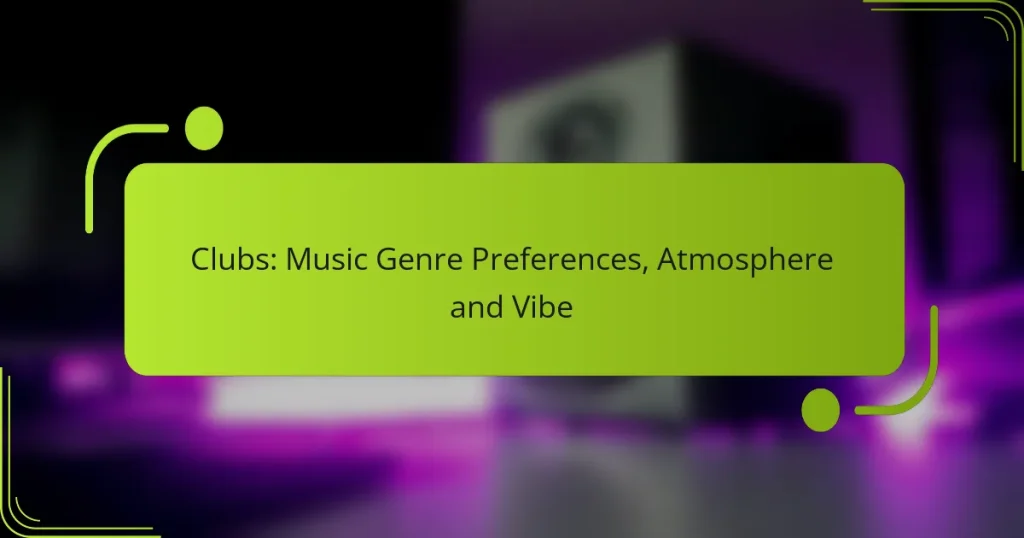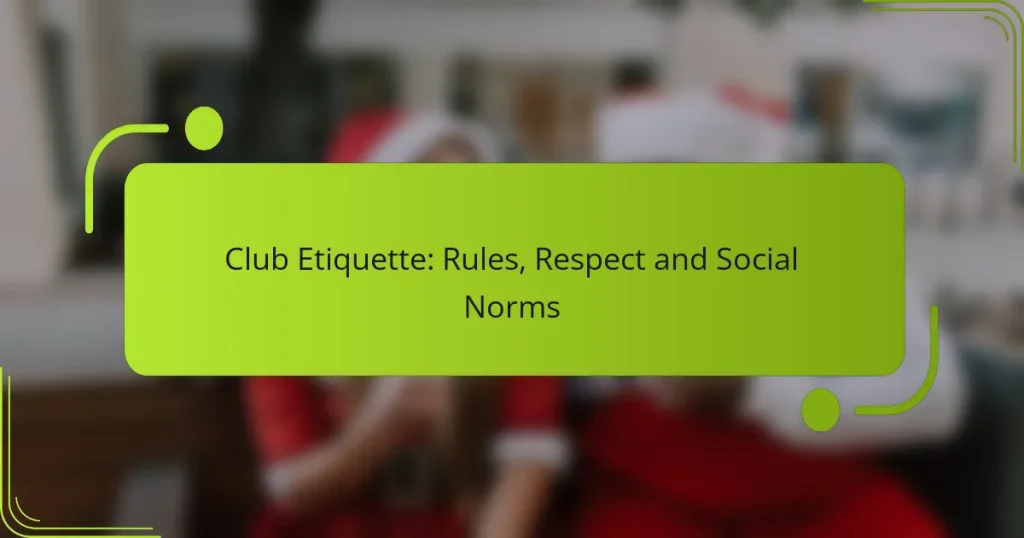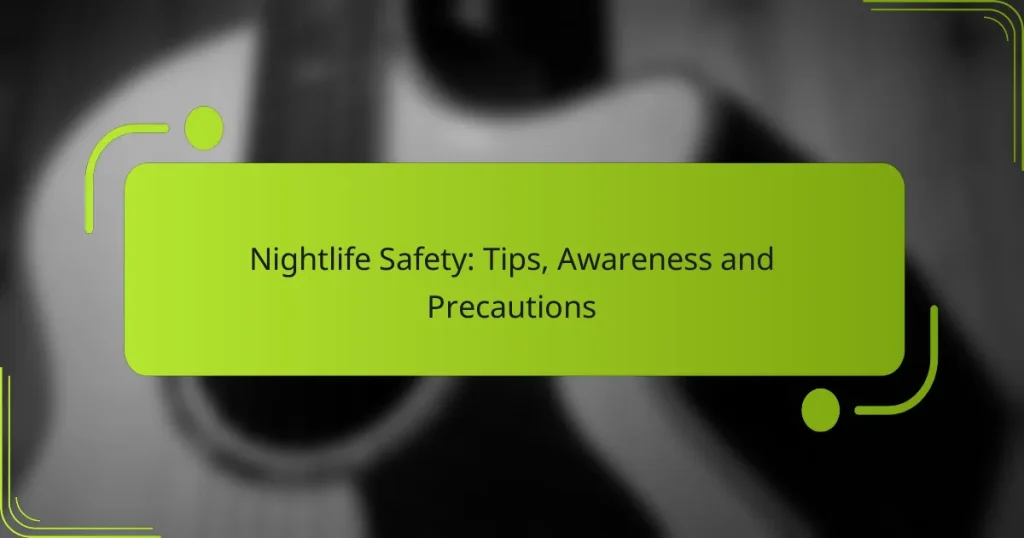The club scene in urban areas is a vibrant tapestry of social interactions, diverse musical influences, and a variety of venues that cater to different audiences. Understanding these dynamics is crucial for anyone looking to engage with or navigate this lively environment, as factors like location, atmosphere, and entertainment options significantly shape the club-goer’s experience. Additionally, emerging trends such as technology integration, sustainability, and inclusivity are transforming how clubs operate, fostering more dynamic and responsible nightlife experiences.
VIP Sections: Exclusivity, Comfort and Experience Enhancement
Clubs: Music Genre Preferences, Atmosphere and Vibe
Club Culture: Trends, Evolution and Future Insights
Club Etiquette: Rules, Respect and Social Norms
Nightlife Safety: Tips, Awareness and Precautions
Local Laws: Regulations, Impact and Club Operations
What are the key dynamics of the club scene in urban areas?
The club scene in urban areas is characterized by vibrant social interactions, diverse music influences, and a variety of venue types that cater to different audiences. Understanding these dynamics is essential for anyone looking to engage with or navigate this lively environment.
Social interaction patterns
Social interaction in clubs often revolves around shared experiences, such as dancing, enjoying music, and socializing with friends or new acquaintances. People typically form groups, but there is also a strong culture of mingling, where individuals may approach others to connect over common interests.
Body language plays a crucial role; confident gestures and open postures can facilitate connections. It’s important to be aware of the social cues in a club setting, as they can vary significantly from one venue to another.
Music genre influences
Music genres heavily influence the atmosphere and crowd dynamics in clubs. Popular genres like electronic dance music (EDM), hip-hop, and pop attract different demographics and create distinct vibes. For instance, EDM clubs often feature high-energy environments with light shows, while hip-hop venues may foster a more relaxed, intimate atmosphere.
Understanding the preferred music styles of a specific club can enhance the experience. Attendees should consider checking the club’s schedule or social media to know what to expect and align their night out accordingly.
Venue types and their roles
Clubs vary widely in type, including nightclubs, lounges, and rooftop bars, each serving unique purposes. Nightclubs typically focus on dancing and live DJs, while lounges may offer a more relaxed setting with seating and cocktails, appealing to those looking for conversation.
Rooftop bars provide a scenic experience, often attracting a crowd interested in socializing with a view. Choosing the right venue based on personal preferences and the desired atmosphere can significantly impact the overall enjoyment of a night out in the urban club scene.
How do club-goers choose venues?
Club-goers typically choose venues based on factors such as location, atmosphere, and the lineup of DJs or performers. These elements significantly influence their overall experience and satisfaction during a night out.
Location accessibility
Location accessibility is crucial for club-goers when selecting a venue. Clubs situated near public transportation or in popular nightlife districts tend to attract more visitors. Additionally, ample parking options can enhance a venue’s appeal, especially for those driving.
Consider the distance from your home or hotel; a club within a short travel time is often preferred. Venues that are easy to reach can lead to higher attendance rates, as convenience plays a significant role in decision-making.
Atmosphere and ambiance
The atmosphere and ambiance of a club greatly impact the overall experience. Factors such as lighting, decor, and sound quality contribute to the vibe, which can either draw people in or push them away. A lively, energetic environment is often favored, especially for dance clubs.
Clubs may cater to different crowds, so understanding the target demographic can help in choosing the right venue. For example, some clubs may focus on upscale clientele with a more sophisticated ambiance, while others might embrace a casual, laid-back feel.
Lineup of DJs and performers
The lineup of DJs and performers is a significant consideration for club-goers. Many people choose venues based on the artists scheduled to perform, as well-known DJs can attract larger crowds. Regularly updated lineups can keep a club relevant and exciting.
It’s beneficial to check social media or the club’s website for upcoming events. Clubs that host popular or emerging talent often see increased attendance, as fans are eager to experience live performances from their favorite artists.
What are the emerging trends in club culture?
Emerging trends in club culture reflect a shift towards technology integration, sustainability, and inclusivity. These trends are reshaping how clubs operate and engage with their patrons, creating more dynamic and responsible nightlife experiences.
Integration of technology
Technology is transforming club culture by enhancing the overall experience for attendees. From advanced sound systems to interactive lighting and virtual reality experiences, clubs are leveraging tech to create immersive environments. Mobile apps for ticketing and cashless payments streamline operations and improve customer convenience.
Additionally, data analytics is becoming crucial for understanding customer preferences and optimizing events. Clubs can use this information to tailor their offerings, ensuring a more personalized experience that keeps patrons coming back.
Sustainability practices
Sustainability is increasingly important in club culture, with many venues adopting eco-friendly practices. This includes using energy-efficient lighting, sourcing local and organic beverages, and implementing waste reduction strategies. Clubs are also exploring partnerships with organizations focused on environmental responsibility.
For instance, some clubs have started to implement recycling programs and encourage patrons to use reusable containers. This not only reduces waste but also appeals to environmentally conscious customers, enhancing the club’s reputation.
Inclusivity and diversity initiatives
Inclusivity and diversity are becoming central to club culture, as venues strive to create welcoming spaces for all individuals. This includes hosting events that celebrate various cultures and identities, ensuring that programming reflects the diversity of the community. Clubs are increasingly aware of the importance of representation in their lineups and staff.
To foster an inclusive atmosphere, clubs can implement policies that promote safety and respect for all patrons. Training staff on diversity and sensitivity can enhance the overall experience, making everyone feel valued and accepted in the nightlife scene.
How does nightlife impact local economies?
Nightlife significantly boosts local economies by generating revenue, creating jobs, and attracting tourists. The vibrant club scene encourages spending in various sectors, from hospitality to retail, enhancing overall economic activity.
Job creation in hospitality
The nightlife industry is a major source of employment, particularly in hospitality roles such as bartenders, servers, and security personnel. Many cities see thousands of jobs created directly through clubs and bars, often providing flexible hours that appeal to a diverse workforce.
Additionally, nightlife can lead to indirect job creation in related sectors, including transportation services like taxis and rideshares, as well as suppliers of food and beverages. This interconnected job market can help stabilize local economies during downturns.
Tourism attraction
A vibrant nightlife scene is a key factor in attracting tourists to a city. Many visitors seek out nightlife experiences, which can lead to increased hotel bookings and spending in local restaurants and shops. Cities known for their nightlife often see a significant portion of their tourism revenue coming from these activities.
Events such as music festivals, club nights, and themed parties can draw large crowds, further enhancing a city’s reputation as a travel destination. This influx of visitors can provide a substantial economic boost, especially during peak seasons.
Local business collaborations
Nightlife venues often collaborate with local businesses, creating mutually beneficial partnerships. For example, clubs may host events featuring local artists or food vendors, which can help promote these businesses while attracting more patrons to the club.
Such collaborations can also extend to marketing efforts, where nightlife venues work with hotels and tourism boards to create package deals that encourage visitors to explore the local scene. This synergy fosters a sense of community and enhances the overall economic impact of nightlife on the local economy.
What are the challenges faced by club owners?
Club owners encounter various challenges that can impact their business operations and profitability. Key issues include regulatory compliance, competition from alternative venues, and shifting consumer preferences.
Regulatory compliance issues
Club owners must navigate a complex landscape of regulations that can vary significantly by location. These regulations often cover licensing, health and safety standards, noise ordinances, and alcohol service laws. Non-compliance can lead to fines or even closure, making it crucial for owners to stay informed and adhere to local laws.
To manage compliance effectively, club owners should regularly consult with legal experts and participate in local industry associations. Keeping up with changes in legislation and maintaining proper documentation can help mitigate risks associated with regulatory issues.
Competition from alternative venues
The rise of alternative entertainment options, such as bars, lounges, and live music venues, poses a significant challenge for traditional clubs. These alternatives often offer unique experiences that can attract the same target audience, making it essential for club owners to differentiate their offerings.
To remain competitive, club owners can focus on creating a unique atmosphere, hosting exclusive events, or offering themed nights. Understanding the local entertainment landscape and adapting to trends can help clubs retain and grow their customer base.
Changing consumer preferences
Consumer preferences in nightlife are constantly evolving, influenced by factors such as social media trends, economic conditions, and cultural shifts. Club owners must be agile in responding to these changes to meet the expectations of their clientele.
Engaging with customers through surveys or social media can provide valuable insights into their preferences. Additionally, offering diverse music genres, innovative drink menus, and unique experiences can help clubs stay relevant and appealing to a broad audience.
What are the best practices for promoting a club event?
To effectively promote a club event, focus on creating engaging content, leveraging social media, and building partnerships with local influencers. These strategies can significantly enhance visibility and attendance.
Utilizing social media platforms
Social media platforms are essential for promoting club events as they allow for direct engagement with potential attendees. Utilize platforms like Instagram, Facebook, and TikTok to share eye-catching visuals, event details, and behind-the-scenes content to generate excitement.
Consider creating a dedicated event page on Facebook to facilitate RSVPs and share updates. Use Instagram Stories and Reels to showcase the atmosphere and features of the event, encouraging followers to share your posts to reach a wider audience.
Engage with your audience by responding to comments and messages promptly. Collaborate with local influencers who align with your brand to amplify your reach, as their followers may be interested in attending your event. Aim for a consistent posting schedule leading up to the event to maintain interest and anticipation.






